

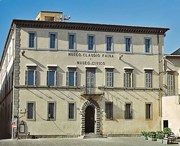
Count Mauro Faina began this collection in the 1860s and housed it in his palace in Perugia. He described it in a letter of 1865 as "a charming little museum of some 300 pieces, some of them outstanding". Mauro was interested in excavation, a hobby he enjoyed at Villa Laviano, near Chiusi, which belonged to his friend Maria Bonaparte Valentini. However, he complained after one such visit: "I spent a lot and found little ... it will be my ruin". His collection of Etruscan coins and ceramics was built up instead in the market. When he died in 1868, Mauro left it to his nephew, Eugenio Faina.
Eugenio moved the collection to Palazzo Faina in 1869. He added local finds to the collection, notably those made by Riccardo Mancini in the necropolis of Crocifisso del Tufo, in order to avoid their dispersal. George Dennis, who visited Orvieto in the 1870s, wrote in his book "Cities and Cemeteries of Etruria": "Most of the produce of Mancini's pickaxe is now stored in the palace of the Conte della Faina - a gentleman whose patriotism and good taste have urged him at great expense to make a collection of the antiquities discovered [in Orvieto] and whose courtesy leaves it at all times accessible to strangers". By 1888 (the date of the first catalogue), Eugenio had established a museum in six rooms on the second floor of the palace.
When Eugenio's son, Claudio Faina died in 1954, he left the collection to the city. The museum was consolidated and re-opened to the public in its present form in 2000. This page does not do justice to the extensive collection, but focuses only on the exhibits from Orvieto.
Finds from the Crocifisso del Tufo Necropolis
As noted above, Eugenio Faina bought a number of objects that were excavated in the 1870s in the necropolis of Crocifisso del Tufo in order to ensure that they remained in Orvieto. This is almost certainly the provenance of a number of finds from the necropolis that are exhibited in the museum. These include a collection of ceramic vases decorated in both the black figure (6th century BC) and red figure (5th century BC) styles, which is exhibited in Rooms 6 and 7. Other notable exhibits include the following:
Greek Vases (ca. 550 BC)
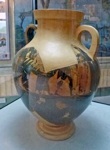
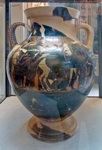

Three large, black figure vases in Room 8 are attributed to the important Greek artist Exekias. Objects like these were used to store the wine used in symposia, a practice that the Etruscans took from the Greeks. The presence of such high-quality possessions among the grave goods of the Crocifisso del Tufo Necropolis attests to the prosperity and sophistication of Orvieto at that time.
Bronze Objects (ca. 600 BC)
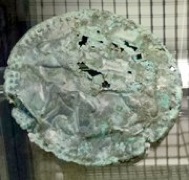
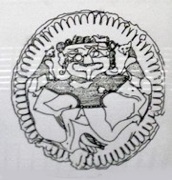
Room 15 contains a collection of eight bronze mirrors, together with a bronze disc (illustrated here). The museum provides a sketch of its damaged relief, which depicted a dancing satyr with leopards on its shoulders.
Vases of the Vanth Group (ca. 320 BC)
The museum exhibits a group of closely related vases that These vases are named for the demon Vanth, who is identified by an inscription on two of them and also portrayed on the third (see below). Vanth traditionally welcomed the deceased to the underworld and was usually portrayed with wings and with snakes wrapped around her arms. The vases, which were probably made in Orvieto, are recorded in the first catalogue (1888) of the museum as coming from an unspecified location in the city. Since the iconography relates to the underworld, they were almost certainly grave goods.
Vase in Room 17
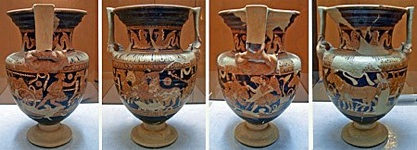
This is the finest of the vases, and has a room to itself. Its mains scenes depict:
-
✴Karun (in Greek, Charon, whose job it was to ferry souls over the River Styx to the underworld) leading a chariot of four horses;
-
✴the chariot containing Hades and Persephone;
-
✴Vanth (not, in this case, identified) following the chariot; and
-
✴a horse-drawn carriage behind her carrying a female corpse.
Vases in Room 18
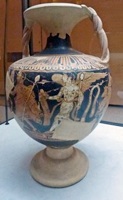
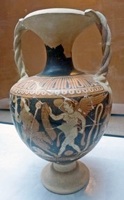
Two other vases in the museum depict Vanth as a naked, winged goddess with a snake around her waist, carrying a scroll that bears her name. This scroll is a symbol of Fate.

